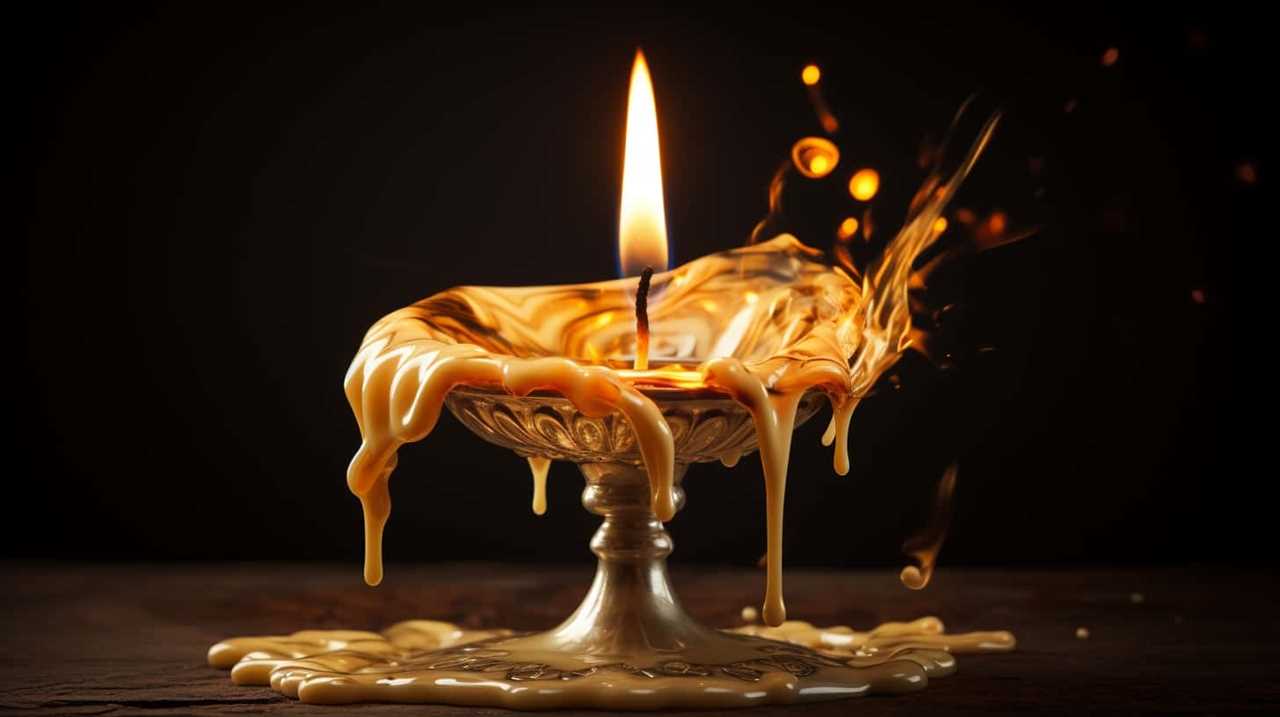The saying, “where there’s smoke, there’s fire,” is often proven to be accurate. But what does it signify when the smoke is coming from your own candle? This interesting situation has left many candle enthusiasts wondering, “Why is my candle giving off smoke?”
Well, fear not, for I am here to shed some light on this smoky situation. In this article, we will delve into the science behind candle smoke, exploring the factors that contribute to its presence and how to minimize it for a more enjoyable and smoke-free experience.
From proper wick trimming techniques to choosing the right candle, we will leave no stone unturned in our quest for a cleaner burn. So, grab your favorite candle and join me as we unravel the mysteries of candle smoke and discover the secrets to a truly blissful ambiance.
Key Takeaways
- Proper wick trimming to about 1/4 inch before each use can minimize smoke production.
- Choosing high-quality candles made from natural materials like soy or beeswax can reduce smoke.
- Fragrance-free candles are recommended to minimize the risk of smoke and soot production.
- Proper candle placement, ventilation, and avoiding drafty areas are important for reducing smoke.
Understanding the Science of Candle Smoke
Do you ever wonder why your candle is smoking? Well, let’s delve into the science behind candle smoke. When a candle burns, it undergoes a chemical reaction known as combustion. During this process, the wax in the candle is heated by the flame, causing it to vaporize.
The vaporized wax then reacts with oxygen in the air, producing carbon dioxide and water vapor. However, if certain factors are not properly balanced, excessive smoke can be produced.
One factor that contributes to excessive candle smoke is an improperly trimmed wick. A long, untrimmed wick can create a larger flame, which in turn generates more heat. This heat can cause the wax to vaporize at a faster rate, leading to an increase in smoke production. Additionally, if the wick is too thick, it may not be able to draw up the melted wax efficiently, resulting in incomplete combustion and the release of smoke.
To minimize candle smoke, it is crucial to trim the wick to a length of about 1/4 inch before each use. This ensures a controlled flame size and promotes better fuel consumption, reducing smoke. By understanding the chemical reactions in the combustion process and taking steps to trim the wick properly, you can enjoy a clean-burning candle with minimal smoke.
Now, let’s explore the proper wick trimming techniques.
Proper Wick Trimming Techniques
To ensure a clean and efficient burn, it’s crucial to trim the wick properly. Wick maintenance is essential for reducing soot and ensuring a smoke-free experience. Here are some tips to help you achieve optimal wick trimming:
-
Trim the wick to ¼ inch: Use a pair of sharp scissors or a wick trimmer to trim the wick to a length of about ¼ inch before each use. This helps prevent the wick from becoming too long and producing excessive smoke.
-
Remove any debris: Before lighting the candle, make sure to remove any debris or charred bits from the wick. This helps promote a clean and even burn.
-
Avoid over-trimming: While it’s important to trim the wick, be careful not to trim it too short. If the wick is too short, it may have difficulty drawing up the wax and result in a weak flame.
-
Trim after each use: After extinguishing the candle, allow it to cool completely and then trim the wick again. This helps maintain a consistent burn and reduces the chances of soot and smoke.
By following these wick trimming techniques, you can enjoy a cleaner and more efficient burn. Now let’s explore the next section about choosing the right candle for a smoke-free experience.
Choosing the Right Candle for Smoke-Free Experience
When it comes to avoiding smoke from candles, selecting high-quality candles is crucial. These candles are often made with premium ingredients that burn cleaner and produce less smoke.
Additionally, it’s important to avoid candles with excessive fragrance or additives, as these can contribute to smoke production. Instead, opt for natural and clean-burning alternatives that prioritize a smoke-free experience.
Selecting high-quality candles
Burning a well-crafted candle will transport you to a cozy cabin, filling the air with gentle fragrance and soft, flickering light. When it comes to selecting high-quality candles, it’s crucial to consider candle burning techniques to reduce smoke production.
Look for candles made from natural, clean-burning materials such as soy or beeswax, as they tend to produce less smoke. Additionally, make sure the wick is made from cotton or other natural fibers, as synthetic wicks can contribute to smoke.
It’s also important to trim the wick to about 1/4 inch before each use to promote an even burn and minimize smoke. By choosing candles that adhere to these guidelines, you can enjoy a smoke-free experience.
Avoiding candles with excessive fragrance or additives is the next step in ensuring a clean-burning candle.
Avoiding candles with excessive fragrance or additives
Steer clear of candles with overpowering scents or unnecessary additives to enhance your candle-burning experience. When selecting candles, opt for fragrance-free options to minimize the risk of smoke and soot production. Excessive fragrance can increase the chances of the candle smoking, as the additional chemicals can interfere with the combustion process. By choosing fragrance-free candles, you can enjoy a cleaner and safer burning experience.
Additionally, avoiding candles with additives such as colorants and dyes can also help minimize smoke production. These additives can release harmful chemicals when burned, leading to increased smoke and soot. Instead, opt for natural and clean-burning alternatives that contain only essential oils and natural ingredients. This will not only reduce the chances of your candle smoking but also create a healthier and more enjoyable atmosphere.
Transitioning into the next section, let’s explore the benefits of opting for natural and clean-burning alternatives.
Opting for natural and clean-burning alternatives
To truly transform your atmosphere, choose natural and nourishing candles that provide a refreshing and rejuvenating experience. Opting for natural candle alternatives not only reduces smoke but also offers a range of benefits. Here are four reasons why clean burning candles are a better choice:
-
Soy Wax: Made from soybeans, these candles burn cleaner and produce less soot, helping to maintain indoor air quality.
-
Beeswax: Known for its natural scent, beeswax candles have a longer burn time and emit negative ions that can purify the air.
-
Essential Oils: Infused with pure oils, these candles release natural fragrances without the harmful chemicals found in synthetic fragrances.
-
Coconut Wax: Derived from coconuts, this wax burns slowly and evenly, providing a longer-lasting illumination.
By opting for these natural candle alternatives, you can enjoy a cleaner and healthier atmosphere in your home. Now, let’s explore burning techniques for smoke reduction.
Burning Techniques for Smoke Reduction
Try adjusting the wick height and you’ll notice a beautiful dance of flame on your candle, with significantly less smoke. Burning techniques play a crucial role in reducing soot formation and preventing excessive flame height, which are the main culprits behind smoky candles.
To start, make sure the wick is trimmed to about 1/4 inch before lighting the candle. A longer wick can create a larger flame, leading to more smoke. Additionally, keep an eye on the flame’s size while the candle burns. If it becomes too big, it’s a sign that the wick needs to be trimmed again.
Another technique is to avoid placing your candle in drafty areas, as this can cause the flame to flicker and produce smoke.
Lastly, be patient when extinguishing the candle. Instead of blowing it out, use a candle snuffer or gently dip the wick into the melted wax until it is fully extinguished.
These simple techniques can go a long way in reducing smoke and ensuring a cleaner burn for your candles.
Now, let’s delve into troubleshooting common issues with candle burning.
Troubleshooting Common Issues
If you’re experiencing issues with excessive soot or uneven burning, troubleshooting common problems can help you achieve a more enjoyable candle burning experience. Understanding soot formation is crucial in addressing excessive smoke. Soot is typically caused by an imbalance between the wick and the size of the candle. A wick that’s too long or too thick can produce more soot, while a smaller candle may not be able to fully burn the wax, resulting in excess smoke.
To reduce soot, trim the wick to about a quarter of an inch before lighting the candle and make sure the candle is the appropriate size for the room.
Another common issue is flickering flames. This can be caused by a draft in the room or by a wick that’s too long. To troubleshoot flickering flames, try moving the candle to a different location away from drafts. If the problem persists, trim the wick slightly to ensure a more stable flame.
Understanding the impact of candle placement is essential for achieving optimal burning conditions. In the next section, we’ll explore how the location of the candle can affect its burn time and overall performance.
Understanding the Impact of Candle Placement
When it comes to candle placement, there are a few key points to keep in mind to ensure a safe and optimal experience. Firstly, it’s crucial to place the candle on a stable and level surface to prevent any accidental tipping or spilling of hot wax.
Secondly, it’s important to avoid placing the candle near flammable materials such as curtains or paper, to reduce the risk of a fire hazard.
Lastly, for proper air circulation and to avoid smoking, it’s recommended to place the candle in an area where air can freely circulate around it, such as on a table or shelf away from any obstructions.
Importance of a stable and level surface
Although it may seem obvious, having a stable and level surface is crucial if you don’t want your candle to resemble a tiny, misguided smoke machine. Here’s why:
-
Stability prevents accidental tipping: Placing a candle on an uneven or wobbly surface increases the risk of it toppling over, causing accidents and potential fires.
-
Avoids uneven burning: A leveled surface ensures that the candle burns evenly, preventing uneven melting and excessive smoke production.
-
Enhances candle safety: A stable surface reduces the likelihood of the candle coming into contact with flammable materials or being knocked over by pets or children.
-
Promotes efficient ventilation: Placing the candle on a level surface allows for proper air circulation, minimizing smoke buildup and reducing the chances of smoke-related issues.
By ensuring a stable and level surface for your candle, you can prevent accidents and promote candle safety. This leads us to the next important step: avoiding proximity to flammable materials.
Avoiding proximity to flammable materials
To ensure the safety of your surroundings, it is essential to keep your candle away from any flammable materials. Preventing candle accidents and practicing fire safety precautions should be a top priority. Placing your candle on a stable and level surface is crucial, but it is equally important to avoid proximity to flammable items. To emphasize the significance of this, let’s take a look at the following table:
| Flammable Materials | Risk Level | Potential Hazards |
|---|---|---|
| Curtains | High | Ignition, rapid spread of fire |
| Paper | Medium | Ignition, sustained burning |
| Fabric | Low | Ignition, slow spread of fire |
By keeping your candle at a safe distance from these materials, you greatly reduce the risk of accidental fires. Now, let’s move on to the next section about optimal placement for air circulation.
Optimal placement for air circulation
For optimal air circulation, make sure to place your candle in an area where there’s plenty of space for the air to flow around it. Maximizing airflow is essential to prevent excessive smoking. Positioning candles away from walls, furniture, and other objects that can block airflow is crucial.
The ideal placement is in the center of a room or on a flat surface with no obstructions. Additionally, avoid placing candles near drafts or open windows, as it can disrupt the airflow and cause uneven burning. By strategically positioning your candle, you can minimize smoking and ensure a clean burn.
Now, let’s delve into the role of candle care and maintenance, which further contributes to a smoke-free experience.
The Role of Candle Care and Maintenance
When taking care of your candle, it’s important to understand the role of proper maintenance in preventing excessive smoking. Understanding candle ingredients and the importance of proper candle storage are key factors in maintaining a smoke-free environment.
To begin with, candles are made from various ingredients such as wax, fragrance oils, and wicks. Different types of wax, like soy or paraffin, can affect the burning process and smoke production. It’s essential to choose candles with high-quality ingredients that are specifically designed to minimize smoke.
Proper candle storage is equally important in reducing smoking. Storing candles in a cool, dry place away from direct sunlight and drafts can help maintain their integrity. Extreme temperatures and humidity can cause the wax to melt unevenly, leading to increased smoke production.
To illustrate the significance of candle care and maintenance, let’s take a look at the following table:
| Candle Care and Maintenance | Effect on Smoke Production |
|---|---|
| Understanding candle ingredients | Minimizes smoke |
| Importance of proper candle storage | Reduces smoke |
By understanding and implementing proper candle care, you can greatly reduce smoke production and enjoy a cleaner burning experience. In the next section, we will explore how to address candle smoke in different environments without compromising the ambiance they create.
Addressing Candle Smoke in Different Environments
When it comes to candle smoking in outdoor settings, there are a few factors to consider.
Windy conditions can cause the flame to flicker and produce more smoke, so it’s important to place your candle in a sheltered area.
In small or enclosed spaces, like bathrooms or bedrooms, proper ventilation is key to prevent smoke buildup. Opening a window or using a fan can help keep the air flowing and reduce smoke.
Lastly, if you’re dealing with windy conditions, consider using a hurricane candle holder or placing your candle inside a lantern to protect the flame and minimize smoke.
Candle smoking in outdoor settings
Interestingly enough, lighting a candle outdoors can sometimes result in a smoky situation. When it comes to outdoor candle safety, it’s important to consider a few factors that contribute to the smoking issue.
First, wind plays a significant role in the behavior of a burning candle. Even a gentle breeze can cause the flame to flicker, leading to an uneven burn and excess smoke.
Additionally, the type of candle you choose can also affect the amount of smoke produced. Some candles, especially those made from lower quality materials or with synthetic fragrances, tend to smoke more.
To prevent candle accidents and minimize smoke, it’s crucial to place the candle in a sheltered area, away from drafts. Furthermore, opting for high-quality candles made from natural materials can help reduce smoke and ensure a more enjoyable outdoor experience.
Moving on to preventing smoke in small or enclosed spaces…
Preventing smoke in small or enclosed spaces
To prevent smoke from becoming an issue in small or enclosed spaces, you’ll want to consider a few key factors.
Firstly, it’s important to ensure proper ventilation. Open windows or doors to allow fresh air to circulate, which can help minimize smoke buildup. Additionally, placing the candle near a draft or fan can also help disperse the smoke.
Another effective method is to choose candles specifically designed for use in enclosed spaces. These candles are often made with lower smoke production in mind. Finally, consider using candles in containers with lids to further minimize smoke. By containing the smoke within the container, you can prevent it from spreading throughout the room.
Transitioning into managing candle smoke in windy conditions, it’s important to take additional precautions.
Managing candle smoke in windy conditions
Gusty winds can pose a challenge when trying to enjoy your candle outdoors, but how can you manage the smoke in these conditions? To manage candle smoke in windy conditions, there are a few strategies you can employ.
Firstly, consider using candles specifically designed for outdoor use, as they’re often designed to resist wind and produce less smoke.
Additionally, placing your candle in a sheltered area, such as under a gazebo or in a screened porch, can help reduce the impact of the wind.
Another option is to use candle accessories like wind guards or candle holders with lids, which can help create a barrier against the wind.
Managing candle smoke in humid conditions can be achieved by ensuring proper ventilation in the area to allow the smoke to dissipate.
On the other hand, preventing smoke in large open spaces can be challenging, but using multiple candles spread out can help distribute the smoke.
Transitioning into the subsequent section about alternative solutions for smoke-free ambiance, it’s important to explore other options beyond candles to create a serene and inviting atmosphere.
Alternative Solutions for Smoke-Free Ambiance
In order to create a smoke-free ambiance, you could consider using electric candles instead of traditional ones. Electric candles are a great alternative to traditional candles because they don’t produce any smoke or soot. They operate using LED lights and batteries, providing a safe and clean option for those who want to enjoy the ambiance of candles without the worry of smoke. Electric candles come in various shapes, sizes, and designs, allowing you to find the perfect fit for your home decor.
Another alternative to traditional candles is using flameless candles. These candles utilize LED lights to create a realistic flickering effect, mimicking the glow of a real flame. Flameless candles are often made of real wax, giving them a more authentic appearance. They’re also a great option for reducing smoke odor, as they don’t produce any smoke or soot.
To further reduce smoke odor, you can consider using scented candles made from natural ingredients. These candles are typically made with soy or beeswax instead of traditional paraffin wax, which can produce more smoke and soot. Natural ingredient candles not only emit pleasant scents but also burn cleaner, leaving behind minimal smoke residue.
By opting for alternative candle types such as electric or flameless candles and choosing scented candles made from natural ingredients, you can create a smoke-free ambiance while enjoying the warm glow and pleasant scents. Transitioning to these alternatives will ensure a cleaner and safer candle experience.
Conclusion and Final Tips for Smoke-Free Candle Experience
For a truly enjoyable and smoke-free candle experience, don’t forget these final tips and tricks! When it comes to troubleshooting issues with your candles, there are a few things you can do to minimize smoke and maximize ambiance. First, always trim the wick to about ¼ inch before lighting your candle. This helps to prevent excessive smoke and ensures a clean burn. Additionally, make sure to place your candle in a draft-free area. Air movement can cause the flame to flicker and produce more smoke.
To further enhance your smoke-free candle experience, consider using a candle snuffer instead of blowing out the flame. This helps to prevent any smoke that may be created during extinguishing. Another helpful tip is to choose candles made from high-quality materials, such as soy or beeswax, as they tend to produce less smoke compared to candles made from paraffin wax.
To summarize, by following these final tips and tricks, you can enjoy a smoke-free candle experience. Remember to trim the wick, place the candle in a draft-free area, use a candle snuffer, and opt for high-quality candles. Now, let’s take a look at the table below for a quick reference guide on troubleshooting common candle issues:
| Issue | Solution |
|---|---|
| Excessive smoke | Trim the wick to ¼ inch before lighting |
| Flickering flame | Place the candle in a draft-free area |
| Smoke during extinguishing | Use a candle snuffer instead of blowing out the flame |
| Choose high-quality candles | Opt for soy or beeswax candles |
By incorporating these final tips and utilizing the table as a reference, you can create a serene and smoke-free ambiance with your candles.
Frequently Asked Questions
How do different types of candles affect the amount of smoke produced?
I bet you’re curious about how different types of candles can affect the amount of smoke they produce. Well, let’s dive into it!
When it comes to burn time, the length of time a candle is burned can indeed impact the amount of smoke produced. Longer burn times can lead to more smoke, as the wick has more time to heat up and release more particles into the air.
Now, let’s move on to wax type. The type of wax used in a candle can also play a role in smoke production. For example, paraffin wax candles tend to produce more smoke compared to soy wax or beeswax candles. Paraffin wax contains petroleum byproducts, which when burned, can release more soot and smoke. On the other hand, soy wax and beeswax are more natural and cleaner-burning options, resulting in less smoke.
So, if you’re looking for a candle with minimal smoke production, go for soy wax or beeswax!
Can the color or fragrance of a candle affect the amount of smoke it produces?
The color and fragrance of a candle can indeed affect the amount of smoke it produces. Fragrance oils and dyes used in candles are often made from synthetic materials that can release more smoke when burned. Darker colored candles may also produce more smoke due to the additional pigments used in the coloring process. Additionally, certain additives, such as certain waxes or oils, can contribute to increased smoke production.
Can candle smoke be harmful to one’s health?
Candle smoke can indeed be harmful to one’s health, especially with long-term exposure. The effects on respiratory health can be significant, as the smoke contains various toxins and pollutants. These can irritate the respiratory system, leading to coughing, wheezing, and even respiratory infections.
Additionally, candle smoke can negatively impact indoor air quality, contributing to poor ventilation and increased levels of indoor pollutants. It’s important to be cautious and minimize exposure to candle smoke for the sake of our respiratory well-being.
Are there any specific tips for reducing candle smoke in outdoor environments?
When it comes to outdoor candle safety and best practices for burning candles in outdoor spaces, there are a few key tips to reduce candle smoke.
First, choose candles with a lower smoke emission rating.
Avoid placing candles in drafty areas that can cause them to flicker and smoke.
Trim the wicks to ¼ inch before lighting, as longer wicks can produce more smoke.
Lastly, ensure proper ventilation in the outdoor area to minimize smoke buildup.
Can the size or shape of a candle affect the amount of smoke it produces?
When it comes to the size and shape of a candle, they can indeed have an impact on the amount of smoke produced. The wick material plays a crucial role in smoke production. For example, candles with cotton wicks tend to produce less smoke compared to those with synthetic wicks.
Additionally, burning time also affects smoke production, as longer burning times can lead to a buildup of soot and increase smoke output.
Conclusion
In conclusion, understanding the science behind candle smoke and implementing proper care and burning techniques can greatly reduce or eliminate smoke while enjoying your favorite candles.
It’s fascinating to note that, according to a study conducted by the National Candle Association, 80% of candle-related smoke issues can be resolved by following simple candle care practices. By regularly trimming the wick, choosing the right candle, and creating a suitable environment, you can create a smoke-free ambiance and enhance your overall candle experience.
So go ahead, light up your candles and enjoy a clean and soothing atmosphere in your home.









